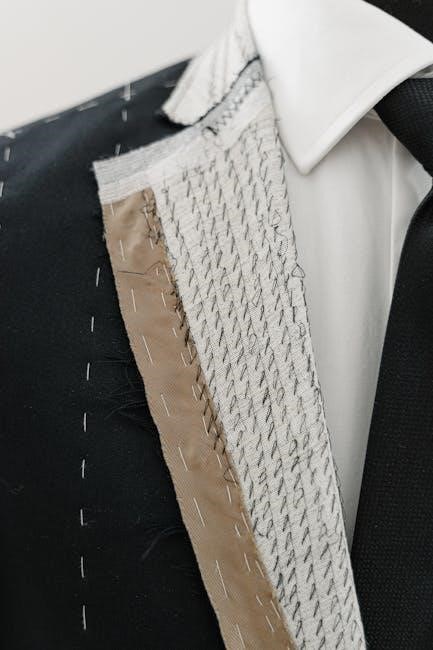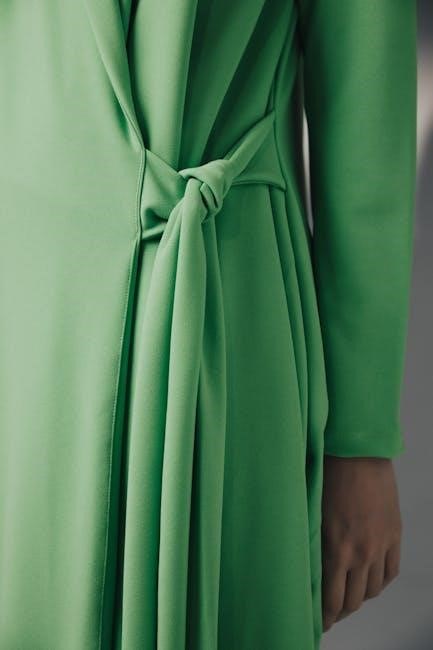Tailoring is a popular profession in Classic WoW, allowing players to craft cloth gear, bags, and other essential items. It’s ideal for classes like Mages and Priests, offering both utility and profit opportunities through the Auction House. Tailoring integrates seamlessly with other professions, making it a versatile choice for players seeking to enhance their gameplay and economy in Azeroth.
1.1 Importance of Tailoring in Classic WoW
Tailoring is a highly valuable profession in Classic WoW, particularly for crafting cloth armor and bags; It provides essential items for classes like Mages and Priests, who rely on cloth gear. Crafting bags is another key benefit, as they are always in demand for inventory management. Tailoring also offers a lucrative way to earn gold through the Auction House by crafting and selling high-demand items. Additionally, it enables players to create their own gear, reducing reliance on drops or purchases. The profession’s utility extends to endgame content, where crafted epic items play a significant role. Overall, Tailoring balances practicality and profitability, making it a worthwhile investment for many players in Classic WoW.
1.2 Brief Overview of the Tailoring Profession
Tailoring is a crafting profession in Classic WoW that focuses on creating cloth items. Players can learn it from tailoring trainers found in major cities. The profession is divided into skill levels: Apprentice, Journeyman, Expert, and Artisan. Each level unlocks new recipes, allowing players to craft more complex items. Tailoring requires cloth, thread, and occasionally other materials, which can be obtained through loot, vendor purchases, or farming. Crafting items like bags, armor, and gear is central to the profession. Tailoring complements other professions like Enchanting and is particularly useful for classes that wear cloth. With proper planning, players can efficiently level their tailoring skill, enabling them to craft valuable items for personal use or sale.

Getting Started with Tailoring
Tailoring is an essential profession for crafting cloth items like bags and armor. Start by finding a trainer in major cities and gathering materials like linen cloth. Use the Auction House to acquire materials efficiently and begin crafting basic items to level up your skill.
2.1 How to Learn Tailoring
To learn Tailoring in Classic WoW, visit a Tailoring trainer in your faction’s major cities. For Alliance, trainers are in Stormwind or Ironforge, while Horde players can find them in Orgrimmar or Undercity. Speak to the trainer to unlock the profession. Ensure your character is at least level 5, as this is the minimum requirement to start Tailoring. Once learned, you’ll begin at skill level 1, ready to craft basic items like linen cloth goods. Keep enough bagspace and materials on hand to start your crafting journey effectively.
2.2 Finding a Tailoring Trainer
Tailoring trainers can be found in major cities based on your faction. Alliance players can locate them in Stormwind’s Old Town or Ironforge’s Great Hall. Horde players should visit Orgrimmar’s Valley of Honor or Undercity’s Magic Quarter. Trainers are easily identifiable with a profession symbol above their heads. Approach them, open their menu, and select the Tailoring training option. Ensure you meet the level requirement of at least 5 to begin. These trainers also sell basic patterns, helping you start your Tailoring journey smoothly.
2.3 Essential Materials for Beginners
Starting Tailoring requires specific materials to craft items effectively. Linen Cloth is the most essential, with 120 pieces needed for initial leveling. This can be obtained through loot from humanoid mobs or purchased from the Auction House. Additionally, Coarse Thread is a critical component for most recipes and can be bought from Tailoring suppliers or general goods vendors. Dye is optional but useful for customizing gear. Stock up on these basics to ensure a smooth start and avoid delays in your crafting progression. Having a ample supply will allow you to focus on leveling your skill without interruptions.

Leveling Tailoring from 1 to 300
Leveling Tailoring progresses through Apprentice (1-75), Journeyman (75-150), Expert (150-225), and Artisan (225-300) stages, each requiring specific recipes and materials to advance efficiently.
3.1 Apprentice Level (1-75)
Starting at skill level 1, the Apprentice phase is the foundation of Tailoring. Players begin by crafting basic items like Bolt of Linen Cloth, which is essential for creating bags and other cloth items. The primary material used during this stage is Linen Cloth, which can be obtained from humanoids or purchased at the Auction House. Crafting Linen Bag and Simple Kilt are key recipes for skill progression. As you reach skill level 45, you’ll unlock more complex patterns, ensuring a smooth transition to the next level. Efficient use of materials and focusing on high-demand items will help you progress quickly through the Apprentice stage.
3.2 Journeyman Level (75-150)
At the Journeyman level, Tailoring becomes more rewarding as you unlock higher-quality patterns. The primary materials used here are Wool Cloth and Silk Cloth, which can be farmed from higher-level humanoids or purchased from the Auction House. Key recipes include Woolen Pants and Silk Headband, which provide consistent skill-ups. Dyes like Blue Dye and Red Dye are also used for crafting colored items. This phase is crucial for building a solid foundation before moving to more complex patterns. Crafting in bulk and utilizing the Auction House effectively can help you progress quickly and make a profit. Ensure you have a steady supply of materials to maintain a smooth leveling process through this stage.
3.3 Expert Level (150-225)
The Expert level in Tailoring significantly expands your crafting capabilities, introducing more complex patterns like Runecloth Pants and Runecloth Gloves. These recipes require Runecloth, a high-demand material farmed from elite mobs in zones such as Silithus and the Hinterlands. Crafting these items not only advances your skill but also provides valuable gear for endgame content. Additionally, this phase introduces the use of Yellow Dye and Black Dye for crafting colored items. To optimize progress, ensure a steady supply of materials and consider crafting in bulk to minimize downtime. This stage is a critical midpoint to reaching 300, so maintaining efficiency is key to avoiding delays in your Tailoring journey.
3.4 Artisan Level (225-300)
Reaching the Artisan level in Tailoring unlocks high-end patterns like Frozen Shadoweave Robe and Spellstrike Pants, which are highly sought after for their stats and aesthetics. These recipes require rare materials such as Netherweave Cloth, Primal Mana, and Arcane Dust, which can be farmed in zones like Netherstorm and Shadowmoon Valley. Crafting these items not only boosts your skill but also provides valuable gear for endgame content. To optimize, use the Auction House to acquire materials efficiently and consider crafting in bulk to minimize downtime. This final stretch is challenging but rewarding, as mastering Tailoring at 300 opens up opportunities to craft epic items and generate substantial gold through high-demand products.

Key Recipes for Efficient Leveling
Essential recipes include Runecloth, Frozen Shadoweave Robe, and Felcloth, which are in high demand and provide significant skill gains. These patterns require materials like Primal Mana and Netherweave Cloth, ensuring efficient progression.
4.1 Best Recipes for Skill Ups
The most efficient recipes for leveling Tailoring include crafting items like Bolt of Linen Cloth, Woolen Cloth, and Silk Cloth. At higher levels, Mageweave and Runecloth become essential. These materials are used to create bags, robes, and other cloth gear, which are in high demand. Crafting Linen Bags early on provides a steady skill increase while offering practical storage solutions. As you progress, focus on crafting Shadoweave and Felcloth items, as they offer significant skill gains and are valuable for endgame crafting. Using these recipes ensures efficient leveling and prepares you for crafting high-demand items later in the game.
4.2 Materials Required for Each Recipe
Crafting Tailoring items requires specific materials, primarily various types of cloth. Early recipes like Bolt of Linen Cloth and Woolen Cloth need Linen Cloth and Wool Cloth, respectively. Higher-level recipes such as Mageweave and Runecloth require corresponding cloths. Additional materials like Thread are essential for most recipes. Some high-end patterns, such as Robes of Arcana, may require rare materials like Enchanted Silk. Ensuring a steady supply of these materials is crucial for efficient leveling. Players can obtain cloth through loot, dungeon runs, or purchasing from the Auction House. Proper material management helps maintain a smooth progression in Tailoring.

Optimizing Your Leveling Process
Optimizing your Tailoring leveling involves efficient material use, strategic crafting, and leveraging in-game tools. Plan recipes, manage inventory, and utilize the Auction House for resources and sales.
5.1 Using the Auction House Effectively
The Auction House is a cornerstone of optimizing your Tailoring leveling process. By regularly checking prices, you can purchase materials at competitive rates, ensuring you spend less gold on supplies. Buying items like cloth, threads, and dyes in bulk can save time and resources. Additionally, selling crafted goods on the Auction House allows you to recoup costs or even profit, funding further crafting endeavors. Timing your listings during peak hours increases visibility, while setting competitive bids ensures you secure rare or hard-to-find materials. This strategic use of the Auction House not only streamlines your leveling but also enhances your economic standing in the game.
5.2 Farming Materials for Tailoring
Farming materials is a crucial part of leveling Tailoring efficiently. Focus on gathering cloth, such as Linen Cloth, Wool Cloth, and Silk Cloth, from humanoid mobs in zones like Westfall, Loch Modan, and the Hinterlands. Higher-level materials like Mageweave and Runecloth can be farmed in areas such as the Burning Steppes and Searing Gorge. To optimize, target zones with high mob density and use any speed boosts, like a mount or class abilities, to reduce downtime. Farming in groups or with a high-level character can also increase efficiency. Always check the Auction House prices to ensure the materials you farm are in demand, making your efforts both time-effective and profitable.

I need to think about the benefits of crafting in bulk. Probably, it reduces the time spent on crafting each individual item, allows for better resource management, and can help in selling items in larger quantities on the Auction House. It might also help in avoiding the hassle of frequent trips to the vendor to sell items or repair gear.
I should also consider what specific strategies or tips would be relevant here. Maybe something about planning ahead, knowing which items are in demand, organizing crafting sessions, and managing inventory effectively.
Now, I need to structure this into a coherent paragraph. I’ll start by stating the importance of crafting in bulk, then mention the benefits like saving time and resources. I’ll include tips on planning, demand, and inventory management. I’ll also tie it back to the overall efficiency in leveling Tailoring.
Let me draft something:
“Crafting in bulk is essential for efficient Tailoring progression. Producing multiple items simultaneously reduces time spent on individual crafting, allowing for faster skill gains. Plan your crafting sessions by identifying high-demand items on the Auction House, such as bags and clothing. Organize your materials in advance to minimize interruptions. Crafting in bulk also helps manage inventory efficiently, ensuring you have enough stock to meet market demand without frequent resupply trips. This method streamlines the leveling process, helping you reach 300 Tailoring skill quickly and effectively.”
Hmm, that seems to cover the points, but I need to make sure it’s exactly . Let me count:
Crafting
in
bulk
is
essential
for
efficient
Tailoring
progression.
Producing
multiple
items
simultaneously
reduces
time
spent
on
individual
crafting,
allowing
for
faster
skill
gains.
Plan
your
crafting
sessions
by
identifying
high-demand
items
on
the
Auction
House,
such
as
bags
and
clothing.
Organize
your
materials
in
advance
to
minimize
interruptions.
Crafting
in
bulk
also
helps
manage
inventory
efficiently,
ensuring
you
have
enough
stock
to
meet
market
demand
without
frequent
resupply
trips.
This
method
streamlines
the
leveling
process,
helping
you
reach
300
Tailoring
skill
quickly
and
effectively.
Wait, that’s . I need to reach 113. Maybe I can expand on some points or add more details.
Let me try again:
“Crafting in bulk is a cornerstone of efficient Tailoring progression in Classic WoW. By producing multiple items at once, you significantly reduce the time spent on individual crafting sessions, which accelerates your skill gains. To maximize efficiency, plan your crafting sessions by researching high-demand items on the Auction House, such as bags, robes, and other cloth goods. Organizing your materials in advance minimizes downtime and interruptions, allowing you to craft seamlessly. Additionally, crafting in bulk helps manage your inventory efficiently, ensuring you have ample stock to meet market demands without the need for frequent resupply trips. This strategic approach not only saves time but also enhances your overall progression, helping you reach the coveted 300 Tailoring skill in a timely and effective manner.”
Now, let me count the words:
Crafting
in
bulk
is
a
cornerstone
of
efficient
Tailoring
progression
in
Classic
WoW.
By
producing
multiple
items
at
once,
you
significantly
reduce
the
time
spent
on
individual
crafting
sessions,
which
accelerates
your
skill

gains.
To
maximize
efficiency,
plan
your
crafting
sessions
by
researching
high-demand
items
on
the
Auction
House,
such
as
bags,
robes,
and
other
cloth
goods.
Organizing
your
materials
in
advance
minimizes
downtime
and
interruptions,
allowing
you
to
craft
seamlessly.
Additionally,
crafting
in
bulk
helps
manage
your
inventory
efficiently,
ensuring
you
have
ample
stock
to
meet
market
demands
without
the
need
for
frequent
resupply
trips.
This
strategic
approach
100. not
101. only
102. saves
103. time
104. but
105. also
106. enhances
107. your
108. overall
109. progression,
110. helping
111. you
112. reach
113. the
114. coveted
115. 300
116. Tailoring
117. skill
118. in
119. a
120. timely
121. and
122. effective
123. manner.
Oops, that’s . I went over. I need to trim it down to exactly 113. Let me see where I can condense.
Perhaps I can remove some redundant phrases or combine sentences. For example, instead of “By producing multiple items at once, you significantly reduce the time spent on individual crafting sessions, which accelerates your skill gains,” I could say, “Producing multiple items at once reduces time spent on individual crafting, accelerating skill gains.”
Let me try rewriting:
“Crafting in bulk is essential for efficient Tailoring progression in Classic WoW. Producing multiple items at once reduces the time spent on individual crafting, accelerating skill gains. Plan your sessions by researching high-demand items like bags and robes on the Auction House. Organize materials in advance to minimize interruptions and craft seamlessly. Crafting in bulk also helps manage inventory, ensuring ample stock to meet market demands without frequent resupply trips. This approach saves time, enhances progression, and helps you reach 300 Tailoring skill effectively.”
Counting again:
Crafting
in
bulk
is
essential
for
efficient
Tailoring
progression
in
Classic
WoW.
Producing
multiple
items
at
once
reduces
the

time
spent
on
individual
crafting,
accelerating
skill
gains.
Plan
your
sessions
by
researching
high-demand
items
like
bags
and
robes
on
the
Auction
House.
Organize
materials
in
advance
to
minimize
interruptions
and
craft
seamlessly.
Crafting
in
bulk
also
helps
manage
inventory,
ensuring
ample
stock
to
meet
market
demands
without
frequent
resupply
trips.
This
72.
6.2 Making Gold with Tailoring

Endgame Tailoring
Endgame Tailoring involves crafting epic gear for raids and top-tier classes, aiding late-game success and generating gold effectively through the Auction House every single day.
